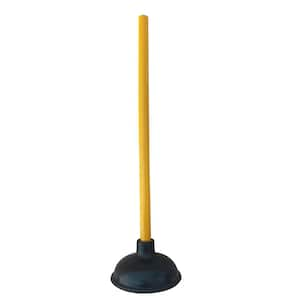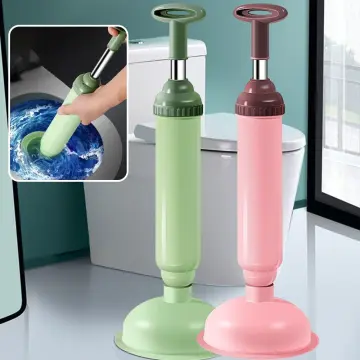Are you trying to locate help concerning How To Use Your Toilet Plunger Correctly in 5 Easy Steps?

Intro
Proper maintenance of house drains is crucial for avoiding obstructions and making sure smooth water flow. One of the key tools in every house owner's toolkit is the plunger, along with different drain cleansers developed to take on stubborn clogs successfully. This short article discovers how to make use of plungers and drainpipe cleaners properly to keep your drains pipes flowing easily.
Section 1: Recognizing Bettors
Types of Plungers
There are a number of kinds of plungers available, each developed for various types of drains pipes and blocks. One of the most typical types include cup plungers, flange bettors, and accordion plungers.
How Plungers Job
Plungers work with the concept of creating stress and suction to dislodge obstructions. When appropriately applied over a drain, they develop a vacuum that can take out debris or separate clogs.
Selecting the Right Bettor
Selecting the ideal bettor depends on the kind of drainpipe and the nature of the clog. Cup plungers are ideal for sinks and tubs, while flange bettors are much better matched for toilets because of their style.
Usual Errors with Bettors
Avoiding these blunders ensures efficient plunging: incorrect seal around the drain, insufficient pressure, and not clearing bordering debris.
Area 2: Utilizing Plungers Effectively
Prep work
Before diving, ensure the bettor covers the drainpipe totally and creates a tight seal. Clear any kind of noticeable debris around the drainpipe opening.
Strategy
Beginning with mild plunging movements to construct suction. Rise stress slowly, making use of a stable rhythm. Repeat as essential till the drainpipe gets rid of.
Repairing Tips
If diving does not work, attempt changing the seal, using petroleum jelly for a far better seal, or utilizing a various type of bettor.
Area 3: Comprehending Drainpipe Cleaners
Types of Drainpipe Cleaning Company
Drain cleaners can be chemical or chemical. Chemical cleansers use strong chemicals to dissolve obstructions, while chemical cleansers use natural enzymes to break down organic matter.
Exactly How Drainpipe Cleaning Company Job
Chemical cleansers respond with obstructions to liquify them, while chemical cleansers break down natural products like hair and oil without hurting pipes.
Safety and security Considerations
Constantly use gloves and eye protection when making use of chemical drain cleansers. Make sure sufficient air flow and comply with manufacturer directions thoroughly.
Eco-Friendly Alternatives
Consider utilizing vinegar and baking soda or enzyme-based cleansers for environment-friendly options that are more secure for pipes and the setting.
Area 4: Utilizing Drain Cleansers Successfully
Application Techniques
Put chemical cleaners directly right into the drainpipe opening. Allow them to benefit the advised time before purging with warm water. Chemical cleaners must rest overnight.
Preventative measures
Avoid mixing various sorts of cleansers, as this can produce harmful fumes. Never ever make use of chemical cleansers in conjunction with a plunger, as splashing can happen.
Managing Persistent Blockages
For relentless blockages, think about utilizing a pipes serpent or calling a specialist plumbing technician to stop damage to pipes.
Verdict
In conclusion, comprehending just how to make use of plungers and drain cleaners successfully is important for preserving healthy and balanced pipes systems. By picking the right devices and techniques, homeowners can tackle minor clogs and stop major pipes concerns down the line.
How to Use a Plunger to Unclog a Drain
The humble plunger is a simple yet effective tool for breaking clogs in sinks, tubs and toilets. This handy tool is easy to use. You can make the most of its power if you understand how it works. Ready to dive in? Here’s what you need to know.
Safety First!
Never use a plunger with drain chemicals. Water will splash as you work, and the chemicals can spatter, burning skin and eyes. It’s a good idea to use rubber gloves and wear safety goggles when you work on a clog.
Choose the Right Tool for the Job
Plungers come in two different styles. Sinks, bathtubs and showers require a cup plunger. Like its name suggests, the rubber end is shaped like a cup. Use a flange plunger on toilets. These plungers have a rubber funnel extending from the cup. A plunger needs to be big enough to cover the drain.
Ready, Set, Plunge!
Coat the rim: Coat the plunger rim with petroleum jelly. This helps make a better seal.
Block outlets: Hold a wet rag over nearby outlets such as the overflow vent or the drain in a second sink.
Release air: Insert the plunger at an angle into the water. Water will displace air in the cup. A water-filled cup is more forceful than one filled with air.
Keep the plunger upright: Hold the plunger perpendicular to the drain. Use fast, forceful strokes, but make the first stroke gentle. The first stroke can create a splash if the cup still contains air. Thrust the plunger 15 to 20 times.
Snap off the plunger: The final stroke should be a strong upward motion that ends when the plunger snaps off the drain.
Repeat the process: you may need to repeat this sequence several times. When the water drains away, your work is done. High-five! https://plumbernw.com/blog/how-to-use-a-plunger-to-unclog-a-drain/

Application Techniques
Put chemical cleaners directly right into the drainpipe opening. Allow them to benefit the advised time before purging with warm water. Chemical cleaners must rest overnight.
Preventative measures
Avoid mixing various sorts of cleansers, as this can produce harmful fumes. Never ever make use of chemical cleansers in conjunction with a plunger, as splashing can happen.
Managing Persistent Blockages
For relentless blockages, think about utilizing a pipes serpent or calling a specialist plumbing technician to stop damage to pipes.
Verdict
In conclusion, comprehending just how to make use of plungers and drain cleaners successfully is important for preserving healthy and balanced pipes systems. By picking the right devices and techniques, homeowners can tackle minor clogs and stop major pipes concerns down the line.
How to Use a Plunger to Unclog a Drain
The humble plunger is a simple yet effective tool for breaking clogs in sinks, tubs and toilets. This handy tool is easy to use. You can make the most of its power if you understand how it works. Ready to dive in? Here’s what you need to know.
Safety First!
Never use a plunger with drain chemicals. Water will splash as you work, and the chemicals can spatter, burning skin and eyes. It’s a good idea to use rubber gloves and wear safety goggles when you work on a clog.
Choose the Right Tool for the Job
Plungers come in two different styles. Sinks, bathtubs and showers require a cup plunger. Like its name suggests, the rubber end is shaped like a cup. Use a flange plunger on toilets. These plungers have a rubber funnel extending from the cup. A plunger needs to be big enough to cover the drain.
Ready, Set, Plunge!
Coat the rim: Coat the plunger rim with petroleum jelly. This helps make a better seal. Block outlets: Hold a wet rag over nearby outlets such as the overflow vent or the drain in a second sink. Release air: Insert the plunger at an angle into the water. Water will displace air in the cup. A water-filled cup is more forceful than one filled with air. Keep the plunger upright: Hold the plunger perpendicular to the drain. Use fast, forceful strokes, but make the first stroke gentle. The first stroke can create a splash if the cup still contains air. Thrust the plunger 15 to 20 times. Snap off the plunger: The final stroke should be a strong upward motion that ends when the plunger snaps off the drain. Repeat the process: you may need to repeat this sequence several times. When the water drains away, your work is done. High-five! https://plumbernw.com/blog/how-to-use-a-plunger-to-unclog-a-drain/

I found that page on How to Unclog Your Sink with a Plunger while doing research the search engines. If you please pause to promote this write-up if you appreciated it. Many thanks for going through it.
Book Appointment